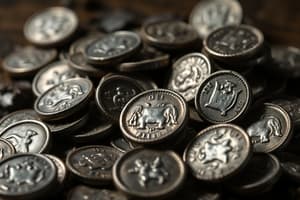Podcast
Questions and Answers
What primary factor distinguished the Chew Valley Hoard discovery from other archaeological finds in Britain?
What primary factor distinguished the Chew Valley Hoard discovery from other archaeological finds in Britain?
Considering Adam Staples' profession as an auctioneer specializing in ancient coins, how did his expertise likely influence the immediate aftermath of discovering the Chew Valley Hoard?
Considering Adam Staples' profession as an auctioneer specializing in ancient coins, how did his expertise likely influence the immediate aftermath of discovering the Chew Valley Hoard?
If the South West Heritage Trust had been unable to purchase the Chew Valley Hoard, what is the most likely alternative outcome for the discovered coins?
If the South West Heritage Trust had been unable to purchase the Chew Valley Hoard, what is the most likely alternative outcome for the discovered coins?
What broader implication can be inferred from the division of the $5.5 million payout between the metal detectorists and the landowner?
What broader implication can be inferred from the division of the $5.5 million payout between the metal detectorists and the landowner?
Signup and view all the answers
Considering the increasing use of technology like metal detectors in archaeological discoveries, which ethical consideration is MOST pertinent for future instances?
Considering the increasing use of technology like metal detectors in archaeological discoveries, which ethical consideration is MOST pertinent for future instances?
Signup and view all the answers
Considering the historical context of the Chew Valley Hoard, what economic implication did the practice of cutting coins in half likely have on local trade and commerce?
Considering the historical context of the Chew Valley Hoard, what economic implication did the practice of cutting coins in half likely have on local trade and commerce?
Signup and view all the answers
If the Chew Valley Hoard represents the annual income of a large estate, what can be inferred about the social and economic structures of England during the late 11th century?
If the Chew Valley Hoard represents the annual income of a large estate, what can be inferred about the social and economic structures of England during the late 11th century?
Signup and view all the answers
Given the political instability of England between 1066 and 1068, which numismatic feature of the Chew Valley Hoard provides the strongest evidence of the complex power dynamics during the early Norman period?
Given the political instability of England between 1066 and 1068, which numismatic feature of the Chew Valley Hoard provides the strongest evidence of the complex power dynamics during the early Norman period?
Signup and view all the answers
Considering the historical context, what does the act of burying the Chew Valley Hoard suggest about the perceived security and stability of the region in 1068?
Considering the historical context, what does the act of burying the Chew Valley Hoard suggest about the perceived security and stability of the region in 1068?
Signup and view all the answers
If the distribution of coin mints across 46 locations in England is considered, what conclusion can be drawn regarding the centralization of power and economic control under either Harold II or William I?
If the distribution of coin mints across 46 locations in England is considered, what conclusion can be drawn regarding the centralization of power and economic control under either Harold II or William I?
Signup and view all the answers
Flashcards
Norman Conquest
Norman Conquest
The 1066 invasion and takeover of England by William I after defeating King Harold II.
Chew Valley Hoard
Chew Valley Hoard
A collection of ancient English coins minted during 1066-1068, likely worth 500 sheep.
King Harold II
King Harold II
The last Anglo-Saxon king of England, defeated in 1066 by William I.
Minting coins
Minting coins
Signup and view all the flashcards
Cut coins
Cut coins
Signup and view all the flashcards
Adam Staples
Adam Staples
Signup and view all the flashcards
Value of the Hoard
Value of the Hoard
Signup and view all the flashcards
Landowner's share
Landowner's share
Signup and view all the flashcards
Date of Discovery
Date of Discovery
Signup and view all the flashcards





